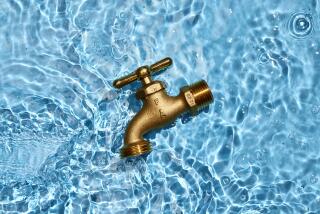New Chloramine Rules Expected to Cause Few Problems, Officials Say
State health officials and operators of kidney dialysis centers say they expect few problems in meeting newly announced standards for the filtration of an additive from public water supplies that poses a potentially lethal threat to dialysis patients.
The additive, chloramine, will be reintroduced as a purifier in public water systems in much of Los Angeles, Orange, San Diego, Ventura, Contra Costa, Alameda and Santa Clara counties beginning about May 1, according to spokesmen for the state Department of Health Services.
The shift from a more commonly used purifier, chlorine, to chloramine--a mixture of chlorine and ammonia--was ordered by the Environmental Protection Agency several months ago to reduce the level of carcinogens formed when unmixed chlorine reacts with certain organic materials in water. Public agencies like the Metropolitan Water District began using chloramine last fall.
Officials said that water treated with chloramine is safe to drink and often tastes better than water treated with unmixed chlorine. The danger, they said, is when water containing chloramine is used in kidney dialysis machines.
Michael McGuire, a water quality manager for the MWD, which serves most of the major cities in Southern California, said that chloramine attacks the red blood cells of people using the dialysis machines.
“The patient becomes weak, anemic, and if the condition is not corrected, it can be fatal,” McGuire said.
Last December, the Department of Health Services, concerned that water containing chloramines had been seeping past filtration systems at several dialysis centers, asked that all public water suppliers discontinue use of the chemical compound for at least 90 days.
Officials said they acted after learning that 18 dialysis patients in the San Diego and Los Angeles areas had required blood transfusions after becoming anemic when treated with water containing chloramines. All the patients recovered.
The failure of the filtration systems to screen out the chloramines properly, the officials said, was the result of human error and mechanical malfunctions.
New Standards
To correct these problems, state Health Director Kenneth W. Kizer said his department developed new procedural and equipment standards--standards that Peter Weisser, a department spokesman, said should be met without difficulty.
The procedures govern the use, maintenance and monitoring of either of two proven filtration systems, Weisser said. One system involves the use of multiple carbon filters; the other uses ascorbic acid to set up a chemical reaction that neutralizes the effects of chloramine.
According to Jerry Simpkins, a licensing and certification specialist with the Department of Health Services, there are about 150 dialysis facilities in the state, of which perhaps half will be served by utilities that will be reintroducing chloramines into the water on or after May 1.
Officials said that inspections by state and county health officials to assure that dialysis filtration systems are performing adequately began March 11 and are expected to be completed in about two weeks.
Although some of the centers have yet to meet the standards, “we expect all of them to comply by May 1,” Simpkins said. “We don’t expect any major problems.”
Upgrading Equipment
A survey of several dialysis treatment centers in the Los Angeles area showed that none of them anticipated any serious problems, either. Most indicated that bringing equipment and procedures up to standards was largely a matter of upgrading existing filtration equipment--usually through the addition of additional charcoal filtering tanks.
While several complained that compliance would be expensive--most estimated the cost at between $2,500 and $10,000--none predicted any significant increase in the cost of individual dialysis treatments.
Kizer said that the relatively few patients using home treatment units in areas that receive chloramine-treated water will be contacted to assure that they are using equipment and procedures that are safe.
“Only after all dialysis facilities within a water district service area are in compliance with the established minimum treatment standards will we allow the water utility to resume the use of chloramines,” Kizer said.
More to Read
Sign up for Essential California
The most important California stories and recommendations in your inbox every morning.
You may occasionally receive promotional content from the Los Angeles Times.










